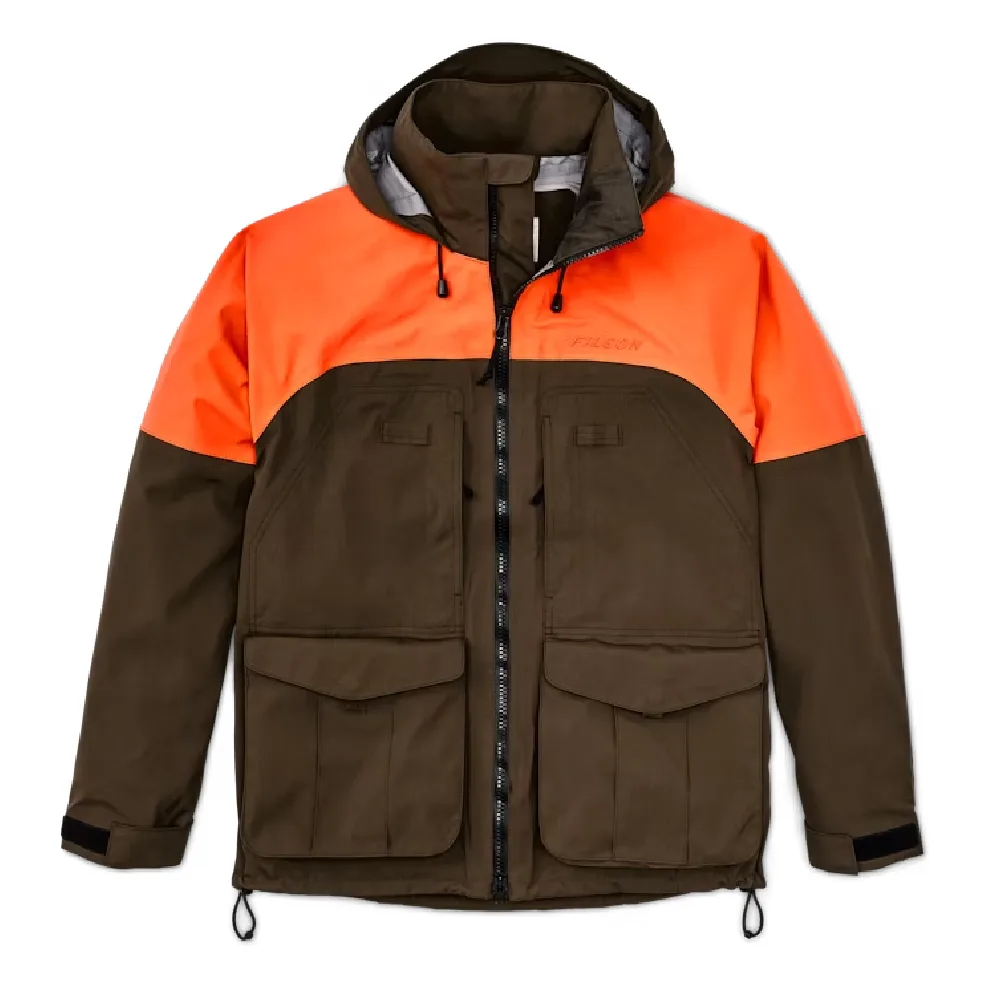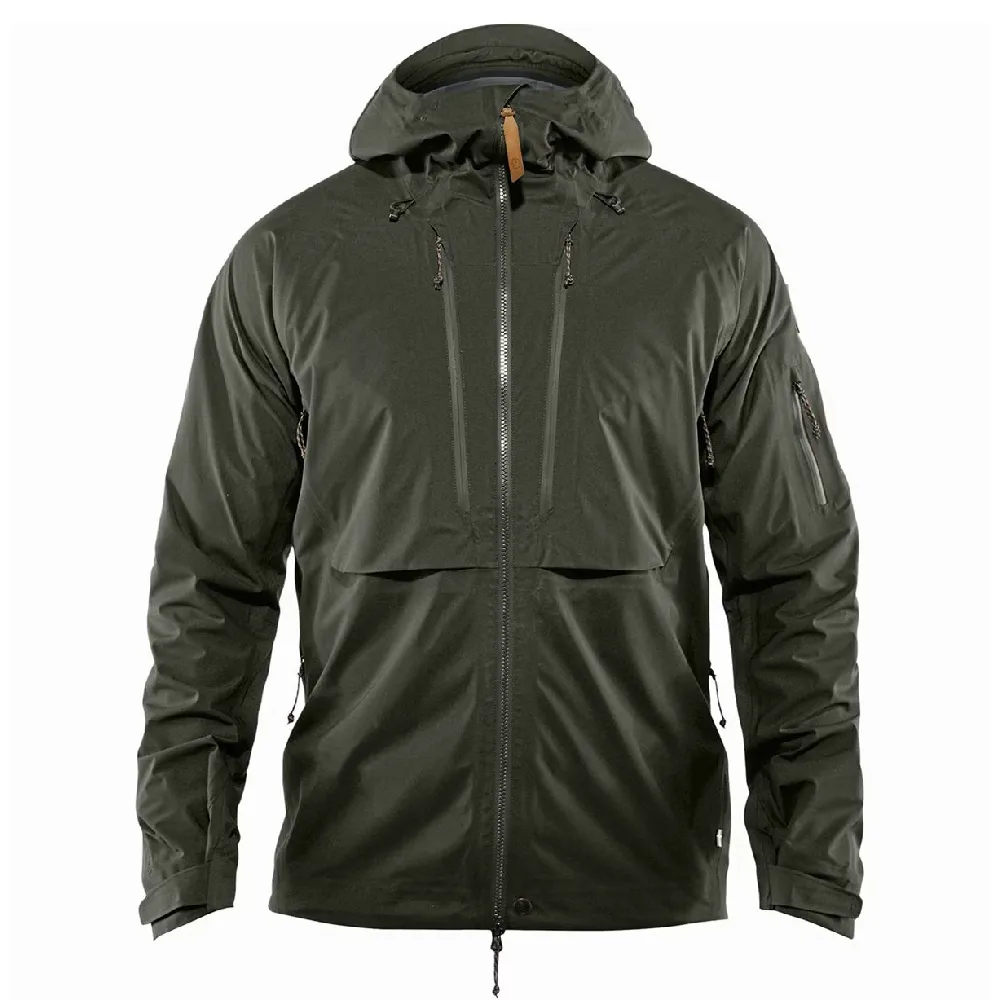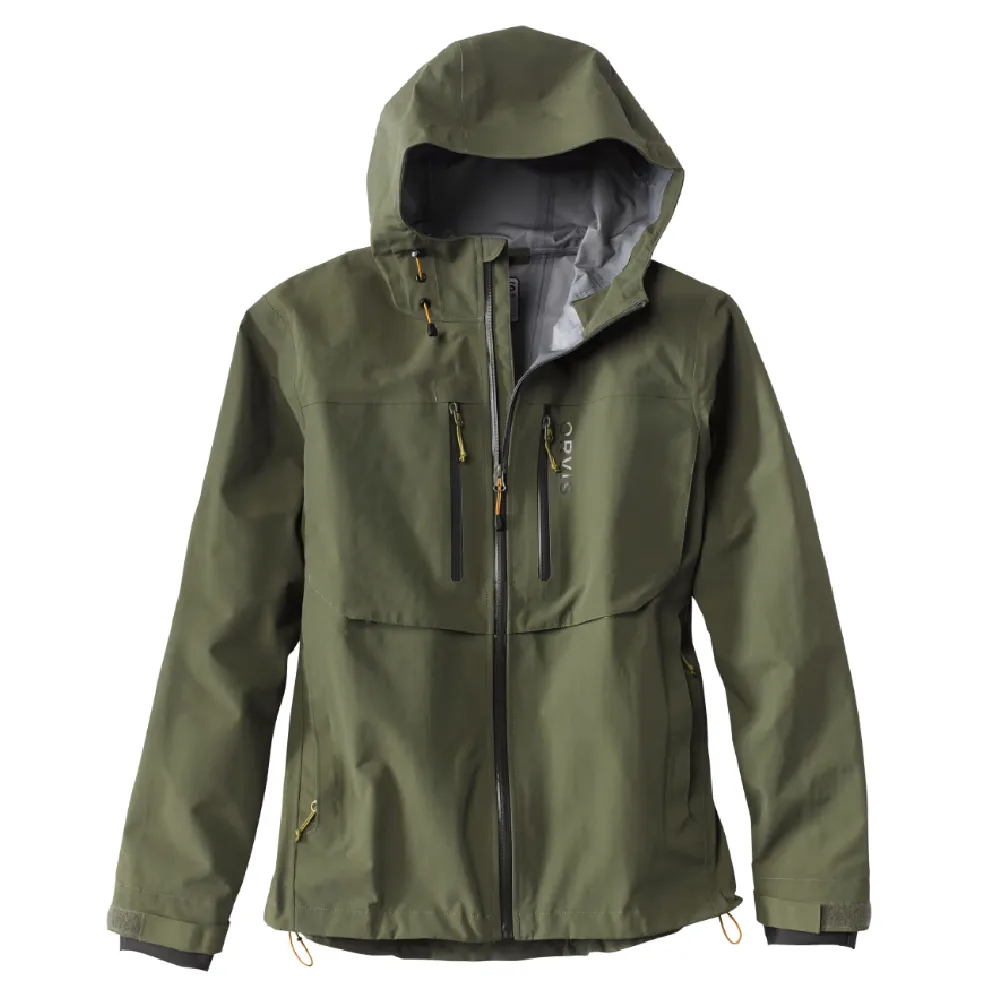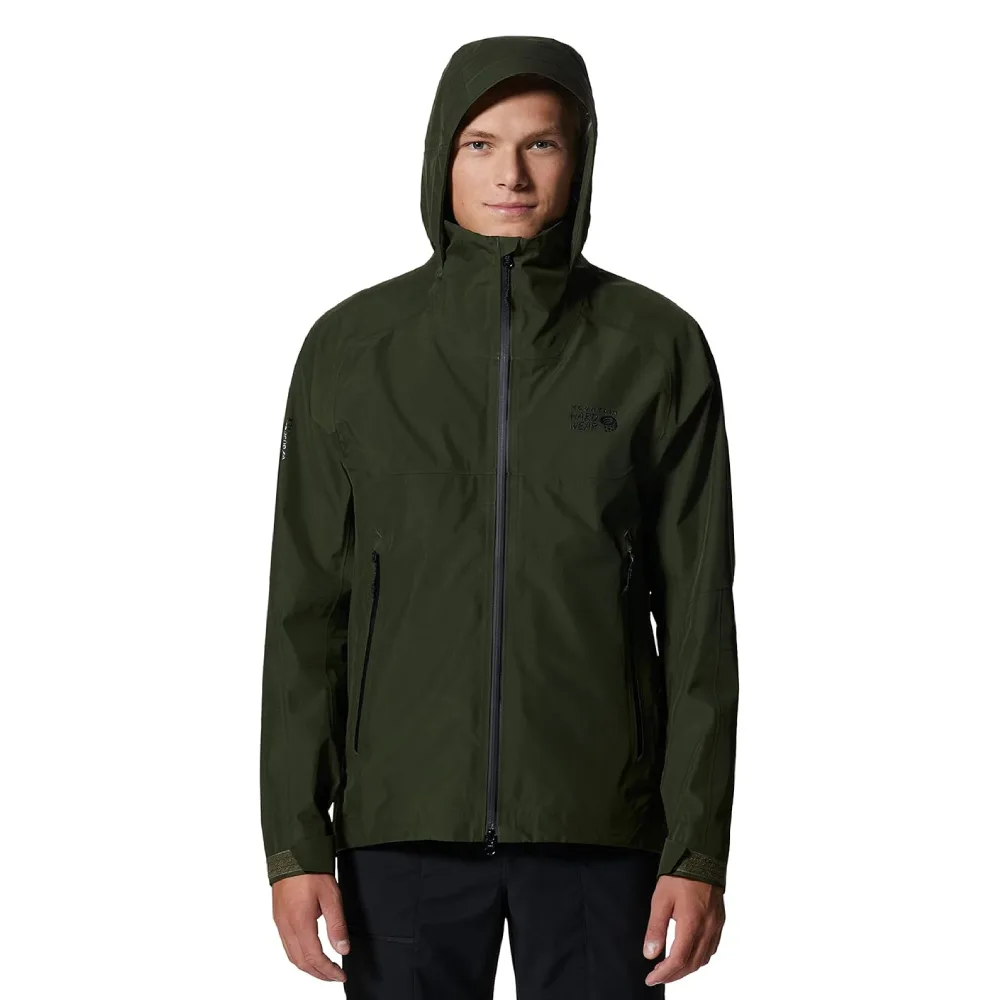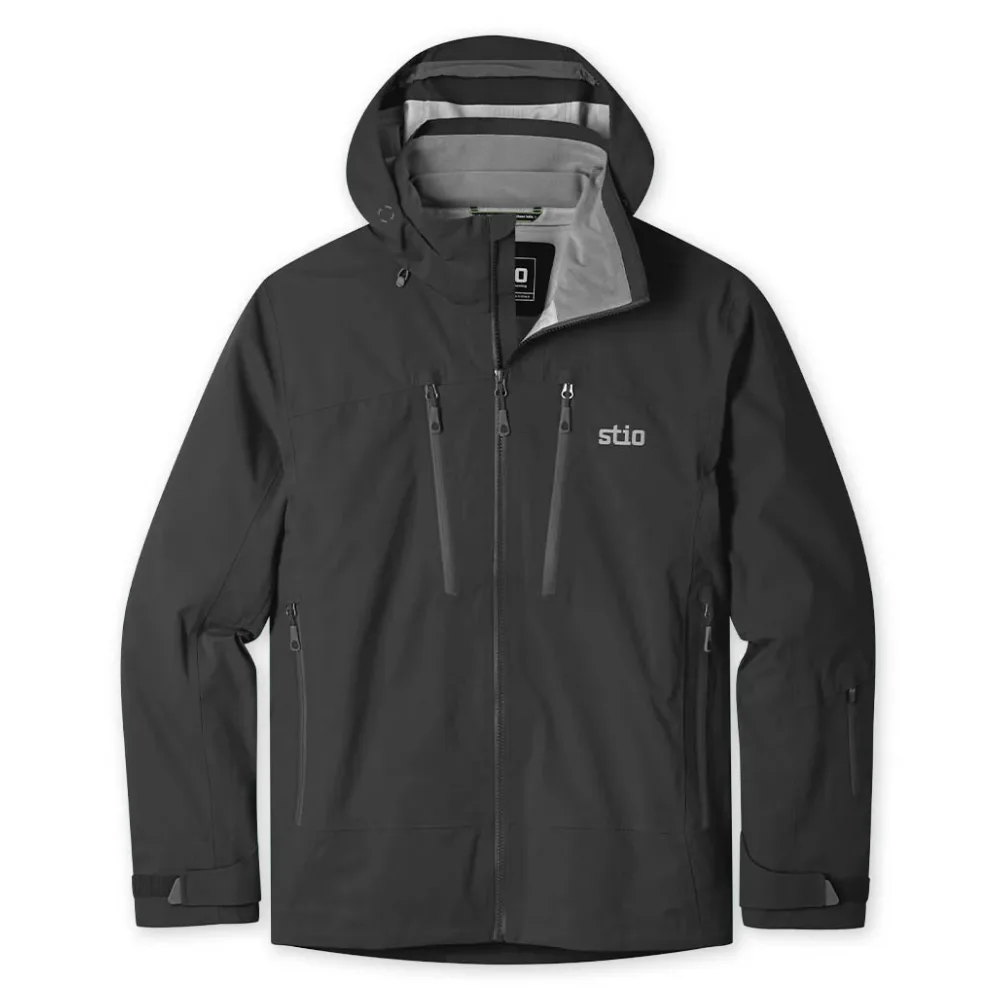We may earn revenue from the products available on this page and participate in affiliate programs. Learn more
By now, you’ve probably heard the saying, “There’s no bad weather, only bad clothes.” That Norwegian phrase has zipped around outdoor types and outfitters alike, usually referenced on days when the heavens open up or when a packing list coincides with a particularly dire forecast. And while the phrase applies to a layering philosophy—wool base layers, quick drying mid-layer, a solid insulating layer—what really moves the needle is the hardshell you choose to wrap it all up in.
The best layer you can pack, for really any adventure, is a hardshell jacket. There are expectations, of course, but really only for those who live on the equator. A hardshell is a durable, waterproof shell composed of three layers: a water-repelling face layer, usually treated with a durable water repellent (DWR) coating; followed by the actual waterproof layer often composed of techs like Gore-Tex or eVent; and a waterproof underlayer, a bonded performance interior layer designed to breathe.
Hardshells repel water and expel the vapor of your own sweat and body heat. Burlier than a rain jacket, most are resistant to punctures and tears from backcountry thorns and brambles. They’re a foundational piece of any outdoor apparel kit, one that merits careful consideration and careful investment. Luckily, we put a whole mess of them through to the wringer, so you don’t have to. Here are the best hardshell jackets campers and hikers can buy.
Best Overall: Patagonia Triolet Jacket
Best Field Jacket: Filson 3-Layer Field Jacket
Best Eco: Fjallraven Keb Eco-Shell Jacket
Best for Fly Fishing: Orvis Clearwater Wading Jacket
Best for Hiking: Mountain Hardwear Trailverse Jacket
Best for Snow Sports: Stio Environ Jacket
Best Overall: Patagonia Triolet Jacket
Specs
Three-layer, durable, waterproof/breathable, and windproof PFC-free Gore-Tex fabric
Helmet-compatible hood with laminated visor and reinforced brim, and two-way adjustment
Two Napoleon chest pockets with watertight zips and zipper garages
Welted, watertight two-way pit zips
Low-profile cuffs use a tapered tab hook-and-loop closure
Weight: 18 oz
Pros
Sleek, integrated pocket design
Concealed Recco reflector
Gore-Tex ePE, containing no perfluorinated chemicals
Designed for the alpine, but an-around outdoor performer across disciplines
Cons
Tricky sizing
Heavier than expected
Slightly more expensive than competitors
Ever since Yvon Choinard started selling rugby shirts, Patagonia has provided battle-tested outdoor gear for those chasing the outdoors’s greatest thrills. The Triolet is the latest in the Patagonia line to follow this need-to-be-there ethos. Patagonia’s team has spent the past ten years quietly partnered with Gore-Tex to remove perfluorinated chemicals from the waterproof fabrics in technical outerwear without compromising performance, resulting in Gore-Tex ePE.
But don’t let the new tech scare you off. The Triolet performed the best of the group across various activities, from biking to running to hiking. It also held its own against chill wind and precipitation, both from the sky and the showerhead in head-to-head testing. This is a hardshell that lessens your impact on the places you play in, while still performing to the highest standards. Designed to withstand an alpine blizzard, getting caught in a sea level rainstorm will feel like training wheels in this jacket. The Triolet does feel a bit oversized than necessary, but I still wouldn’t recommend sizing down. I stuck with my normal size large and it just felt a tad big in some scenarios.
Best Field Jacket: Filson 3-Layer Field Jacket
Specs
16,000 mm waterproof rating
18,500 g/m²/24h of breathability
Fully seam-sealed
Gusseted shell, chest, and interior-security pockets
Rear zippered game bag
Ventilating pit-zips, two-way adjustable hood, and Velcro adjustable cuffs
Pros
Burly shell fabric stands up to thorns and branches
Ample pocket space
Gear loops on chest
Cons
Heavy
Low breathability
Sizing runs a full size large (something to know before you order)
Currently only available directly from Filson or local Filson outfitter
Filson designed this jacket for upland hunting expeditions, but it can do much more. Outdoor disciplines have a long history of repurposing bomber gear across pursuits. So while, yes, wear this on your next pheasant hunt, wear it on your hike or your morning commute too. This jacket contains four pockets on the front, including two chest pockets and large shell pockets that are snap and gusset expandable. You can open these bad boys with one hand, even gloved, which is a huge plus when your hands are otherwise occupied. And the large zipped game pocket on the back of the jacket is a versatile plus, equally capable of holding a grouse or quail as a, say, a toddler’s fleece you’ve fought all morning to get on him.
Michigan’s state and DNR land, where I do much of my exploring, is a hunter’s paradise, so the pop of blaze orange on the shoulders of this jacket has made it a go-to. And in colder inclement weather, it combines seamlessly with Filson’s Down Liner Jacket, zipping in easily and eliminating the rub that can sometimes accompany multiple layers.
At 1.5 pounds, it’s one of the heaviest jackets on this list, not ideal for ultralight pursuits or fast summit attempts. And a word of caution on sizing: order a size smaller. At 6’1” and 200 pounds, I’m a true large for most of these brands, but a medium for Filson.
Best Eco: Fjallraven Keb Eco-Shell Jacket
Specs
Material: Eco-Shell 3-layer Stretch: 100 percent polyester
Water column: 30000 mm
Breathability: 26000 g/m²/24h
Back length: 80 cm
Weight: 520 g
Helmet-compatible hood with drawcord adjustment
Aquaguard, two-way zipper
Fully taped seams
Pros
Well-designed features
Environmentally friendly build
Impressive performance
Built-in fabric stretch aids movement
Cons
Zippers on outer pockets are water resistant, not waterproof
Dries slower than others on this list
Expensive, especially for not using any third-party waterproofing tech
Pronouncing this Swedish brand’s name is the only trouble the Keb will give you. In a list of really fantastic candidates, the Keb Eco-Shell emerged as a clear winner and daily choice to fend off cold and inclement weather. The jacket feels supple, a soft touch that belies its hard-wearing waterproof capabilities. At a 30,000mm rating, this jacket took on rain, windy bike rides, and the double-headed nozzle of our home shower with confidence. The cut is roomy enough for layering insulation underneath without being cavernous when worn over a simple baselayer. The pockets are streamlined and intelligently placed, and the side vents are cleverly adjusted from the standard armpit position to the sides of the torso, which still allows temperature control and easy access to fleece jacket pockets.
In head-to-head testing, the DWR face fabric of the Keb dried slower than other Gore-Tex treated jackets. But even with the slower dry time, no water soaked through to the jacket’s interior. The biggest issue is the zippers. The Aquagaurd waterproofed double zipper is hard to engage unless you use the bottom snap, and the clever placement of the side zips felt enough like actual pockets that, on more than one occasion, I dropped my keys through them and onto the ground. The bigger problem comes with the chest and arm pockets, which are water-resistant but don’t feature the same Aquaguard tech as the main zipper, which should be standard at this price point. There are interior zippers to stash import documents and electronics, but it’s a disappointing detail on an otherwise superior jacket. Ultimately though, when the clouds came in, I consistently reached for the Keb Eco-Shell even when I had plenty of other jackets on deck for testing.
Best for Fly Fishing: Orvis Clearwater Wading Jacket
Specs
20K waterproofness and 15K breathability rating
Three-layer nylon shell fabric with fully taped seams
YKK AquaGuard water-resistant front closure
Two large front storage pockets and two handwarmer pockets
Integrated Dolphin Skin cuff system
Three-way adjustable storm hood with laminated brim
DWR (Durable Water Repellent) finish
Pros
Excellent price-to-feature ratio
Waterproof neoprene “dolphin-skin cuffs” create extra waterproofing along the sleeves
A higher wading jacket cut allows for increased torso movement when angling or paddling
Cons
Limited off-water usage
The Clearwater Wading Jacket is a prime example of Orvis’ category leading outerwear. This three-layer nylon shell is effectively waterproof and breathable. And while the price tag doesn’t fall into the “budget” category, it’s refreshing to see a performance-packed shell in the mid-range price. The real winner for me, though, is the Dolphin Cuff System, an integrated neoprene wrist gaiter designed to keep your arms dry when releasing a fish. I’ve found it’s also incredibly effective for paddling: solving the problem of water dripping down your paddle and up your sleeves. The higher cut of the jacket, designed to integrate with the brand’s fishing wader, allows for unfettered torso movement while paddling, even with a PFD fitted over the jacket. It’s not a paddling-specific jacket (like NRS’s excellent Endurance Jacket), but it’s an astonishingly efficient all-sport solution for any water activity.
Best for Hiking: Mountain Hardwear Trailverse Jacket
Specs
100 percent recycled waterproof, breathable 3-layer Gore-Tex offers
Drop-hood design with three-way drawcord adjustment
Two water-resistant zippered hand pockets
Water-resistant two-way center front zipper
Hook-and-loop adjustable cuffs
Dual drawcord hem adjustment
Pros
Gore-Tex ePE waterproofing tech
Sleek, lightweight fit
Integrated internal hook for optimum campsite drying
Cons
Only two exterior pockets
The name might be a dead giveaway, but the Mountain Hardwear Trailverse jacket is tailor-made for hiking. Think of this jacket as a one-size-fits-all solution to inclement weather you might encounter on the trail. The sleek, no-frills approach to waterproofing and jacket build works in the Trailverse’s favor. It fits well, adjusts quickly, and plays well with backpacks (something not every jacket we tested can say). The collar is high-necked, a nice touch that allows heat retention in colder conditions, even when the hood is down. Plus, it’s built with the Patagonia-pioneered Gore-Tex ePE for environmentally conscious waterproofing.
Did I say no frills? Let’s say all business with one exception. The Trailverse has an ingeniously hidden d-ring on the interior of the jacket, inconspicuously covered by a peekaboo fabric flap. Like a billionaire’s secret bookcase door but for the outdoors. This small but mighty hook allows you to hang the jacket at your campsite at the perfect angle, allowing airflow over every surface and avoiding the dreaded problem of wet spots on an otherwise dry jacket in the morning.
Best for Snow Sports: Stio Environ Jacket
Specs
10,000 g/m2/24hrs breathability
20 Denier Tricot Backer
194 g/m2, 80/20 PFC Free DWR Finish
Removable, adjustable, helmet-compatible hood with bonded brim
Zippered sleeve pocket for RFID ski pass
YKK water-resistant Aquaguard Vislon at center front zipper
Weight: 29 oz.
Pros
Chock full of snow-specific features
Excellent combination of weather resistance to breathability
Long-lasting performance
Cons
Heavy
Limited use outside of snow sports
Stio, a Jackson Hole based outdoor brand, sometimes flies under the radar on product roundups and best of the year lists. It shouldn’t. The brand is firmly embedded in mountain life, has a strong environmental track record, and churns out subtly fantastic products in spades. Their Pinion Hooded down jacket has become a go-to for me on light and fast bikepacking trips where extra insulation is needed, and their Exploit rain shell kept me dry and warm during a surprise rainstorm while floating a section of Utah’s Green River this past summer.
But when it starts snowing, I reach for the Environ shell. It is packed full of features that make it ideal for all day on the mountain, including an adjustable snow skirt, ventilating pit zips, and zipper tabs ideal for opening while wearing gloves. A removable hood lets you customize the fit for bluebird days, and generously sized pockets fit bulky mittens or other snow accessories.
This makes it a go-to jacket, not just for skiing or snowboarding, but for any activity in cold weather, from snow-shoeing to winter biking. But this is a snow jacket, meaning it is built to be worn in the snow and not when it is sunny and above 32 degrees. So if I’m packing for a trip that has both snow and rain, I’m choosing an all-around like the Triolet or the Keb. But if I’m strictly in a winter wonderland, the Environ is my choice.
How We Picked the Best Hardshell Jackets
I finished college by completing a National Outdoor Leadership School (NOLS) program in Alaska, where, as it turns out, Gore had set up a side shop using semester students as guinea pigs for field testing new equipment and technologies. Gore, if you don’t know, invented Gore-Tex, the omnipresent, gold standard of chemical waterproofing. Well, our class lucked out. The Gore folks realized they didn’t have an established baseline for competitor products, so they sent us out in the field with a variety of kits scoring Gore-Tex against the then relative newcomers—eVent, Patagonia’s in house-H2NO, and a handful of others.
It’s been a long time since I handed in the thrashed Rab hardshell and my tester’s notebook, but my quest to find the perfect hardshell hasn’t waned since. While the jackets below didn’t make it into the Alaskan backcountry, they were put to the test backpacking through the Grand Canyon, paddling Utah’s Green River, bikepacking Northern Michigan’s sandy hills, and daily wear and tear while commuting, trail running, and hiking. Not every jacket made the final cut, but those listed here emerged as the best of the best in both individual and head-to-head category tests. To cap it off, I wore each jacket while getting sprayed with the garden hose in my backyard. And there might not be a better way to test waterproof ability than having your family drench you with a hose.
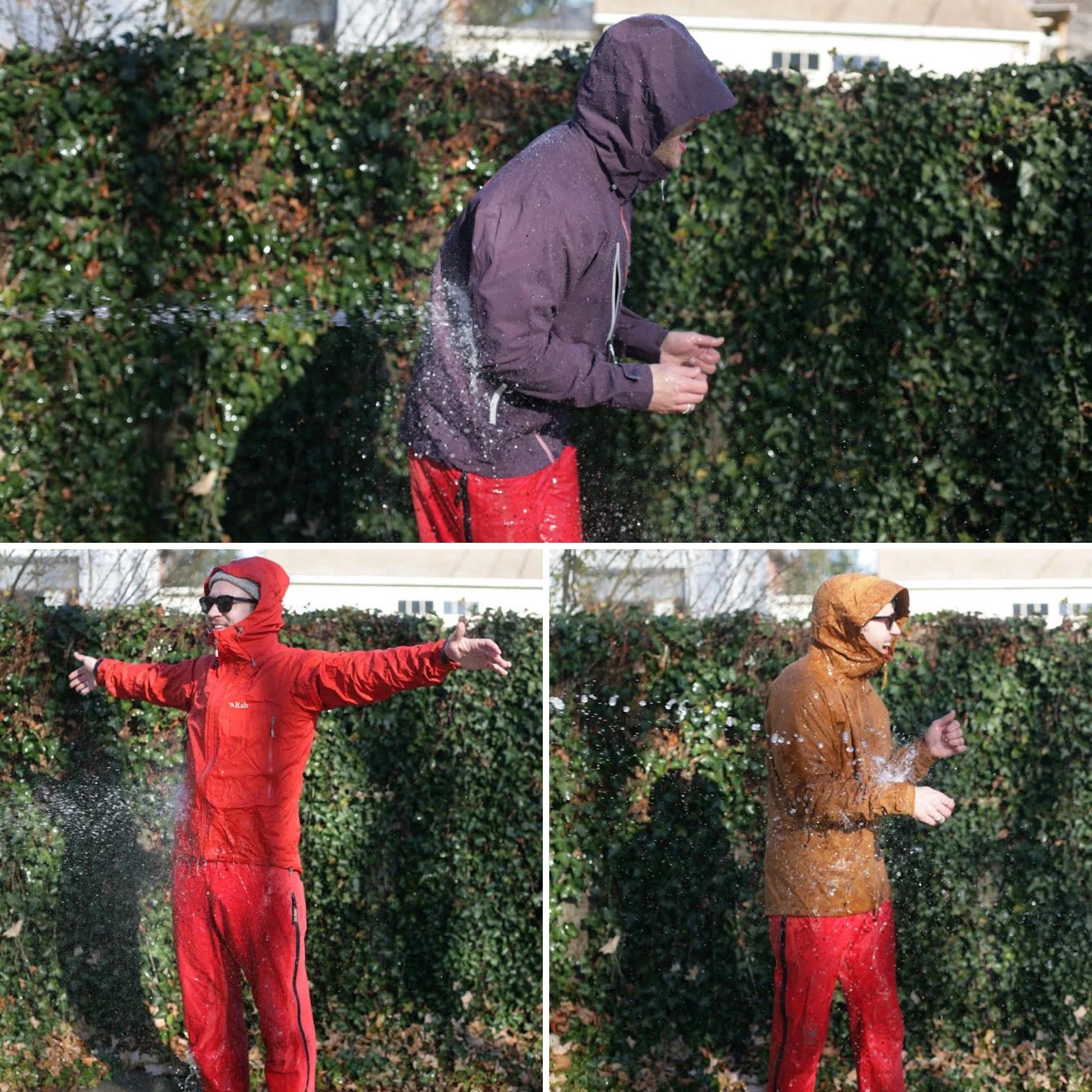
What To Consider When Buying a Hardshell Jacket
Hardshell jackets are one of the most important pieces of gear an outdoor enthusiast will own. Whether it’s hiking, biking, fishing, running, paddling, or any other activity outside, staying dry and cool is crucial. Below are a few factors to think about and consider before buying your next hardshell jacket.
Hardshells vs. Rain Jackets
These days the line between hardshells and rain jackets is blurrier, as technology makes 3-layer, moisture-dumping shells more and more common. But there still remains a difference. Think of it as elementary school geometry: a square is always a rectangle but a rectangle is not always a square. A hardshell will always function as a rain jacket, but a rain jacket will not necessarily be a hardshell. A quick and easy test is to look at how many layers the jacket is built from. Good rain jackets can be found in the two and 2.5-layer varieties. A hardshell will always have three layers, offering the utmost in outdoor waterproofing.
Waterproofing and Breathability
Waterproofing is generally marked by how much water a fabric can take on over 24 hours before the jacket fails. The bottom floor for rain jackets is 5,000mm, but most hardshells will clock in over 15,000mm, and many on this list top out at 30,000mm, which is some serious protection from the elements.
While Gore-Tex, and Gore-Tex Pro in particular, remains the gold standard of breathable waterproofing technology, it doesn’t have a monopoly on the market. Dermizax, eVent, and a handful of others make a competitive bid against Gore’s reigning supremacy. And several brands on this list developed proprietary technologies to best fit how their jacket is designed. In general, you will pay more for a shell with Gore-Tex or similar third-party waterproofing tech. But in exchange, you have a virtual guarantee of peak industry performance when it counts.
Breathability is measured by how much water, in vapor form, will escape the jacket before the dreaded wetout. That’ll come out as a gram measurement and they range as widely as the waterproofing ratings do. But the same rules apply, a score between 5,000-6,000 grams will be on the lower end of breathability seen in outdoor jackets, while some on this list have a rate of 20,000 grams or more.
Activity
This one may seem obvious, but different usage occasions require different features. Hardshells, in particular, tend to run on the pricier side, so consider where and when you’re recreating. A jack-of-all-trades type recreator might lean towards an all-arounder like Patgonia’s Triolet, a day hiker who doesn’t stray from the blazed trail probably won’t need the rugged brush protection of Filson’s Field Jacket, and the backpacker taking on a 3-month trek of Southeast Asia should steer away from slope-side styles.
Fit
Most hardshell jackets are designed to accommodate various levels of layering underneath. Jackets designed for snow sports will run slightly larger to accommodate various levels of insulation, wading jackets are cut higher to pair with waders and help with the constant motion of casting, and running-specific jackets are cut snugly. We recommend diving deep into the brand’s measurements. Use a jacket that fits you well already, and take measurements from pit to pit, sleeve length, and torso length. This will be a better indicator than sticker size on hardshells.
FAQs
Q: Why are hardshell jackets so expensive? There’s a complicated answer and a not-complicated answer here. The complicated one: Hardshells are among the most technical pieces of outdoor kit you can buy. Arguably even the most technical. The fabrics, technology, and fits take years to design. Often, brands integrate third-party waterproofing tech like Gore-Tex and eVent. All of this requires people, processes, and years of R&D. Add to that the growing push to eliminate PFOS and introduce more sustainability via factory transparency and fair wages into the product lifecycle, and it just gets complicated.
The simple answer is basic economics: Hardshells cost a lot to make, so they sell for even more. We’ve tried to include a range of options for every budget, ranging from the Decathlon Quechua at $120 to Snowpeak’s Graphene at over $700.
Q: How long does a hardshell jacket last? Frequency of use, conditions of use, and level of care all play a role in how long a hardshell lasts. A field guide might have to replace a jacket once every other season, a weekend warrior could hold onto theirs for a decade or more. The key is proper care and maintenance. Never put a jacket away wet when you can help it, try to keep it away from extreme heat, and fix problems when they’re small instead of waiting until they get bigger.
Q: How to keep your hardshell jacket clean? Many of these jackets are machine washable, but beware of washing with regular detergent, which can strip the DWR coating. Instead, look at products made specifically for washing waterproof jackets, like those from Nikwax. Niwax also makes products that reestablish the DWR coating, which, regardless of care, will need restoration after frequent use.
Q: What do you wear under a hardshell jacket? While this answer depends on the weather, a good system to establish involves a baselayer from wool or synthetic fibers, a good active mid layer (like a fleece or knit), and an optional insulating layer such as a down or synthetic jacket. Making sure each layer is built from performance fabric will help the hardshell perform to its optimum breathability.
Final Thoughts
While each jacket will keep you warm and dry on backcountry adventures, Patagonia’s Triolet is our choice for an all-around winner in the hardshell category. Designed for alpine conditions, the Triolet threads the needle between hardy enough to resist abrasion and lightweight enough to not impede activity. And while it may be designed for a high-altitude blizzard, it’ll also work in downcountry rainstorms or good old Midwestern sleet. Add in the new, Gore ePE tech eliminating PFOS and PFOA from the shell’s composition, and the Triolet gets our pick for best hardshell.
Why Trust Us
For more than 125 years, Field & Stream has been providing readers with honest and authentic coverage of outdoor gear. Our writers and editors eat, sleep, and breathe the outdoors, and that passion comes through in our product reviews. You can count on F&S to keep you up to date on the best new gear. And when we write about a product—whether it’s a bass lure or a backpack—we cover the good and the bad, so you know exactly what to expect before you decide to make a purchase.



